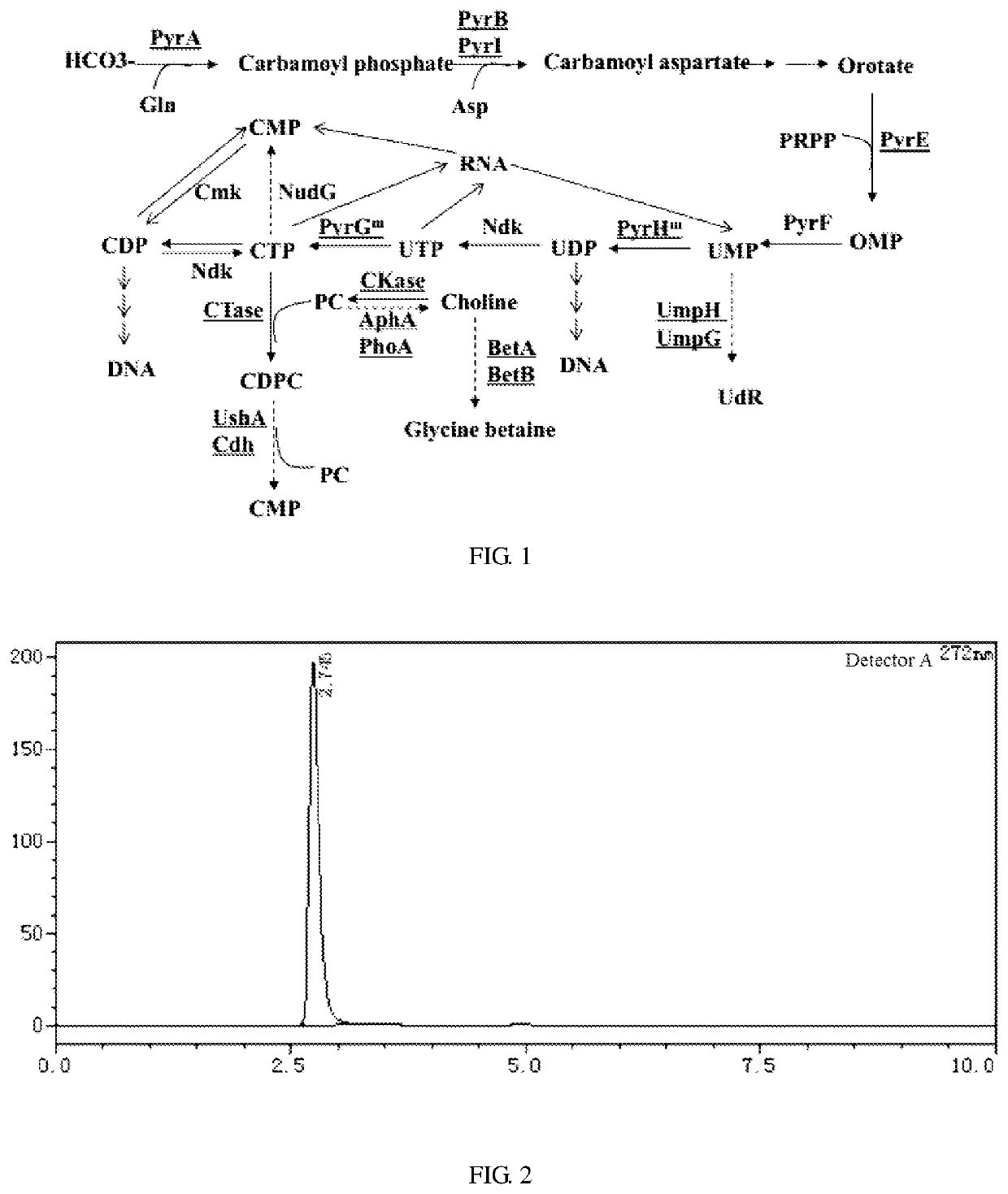Recombinant microorganism for producing citicoline and method for producing citicoline
a microorganism and citicoline technology, applied in the field of biotechnology, can solve the problems of low reaction conversion rate, many by-products, and high cost, and achieve the effect of accelerating the synthesis of carbamoyl phosphate, reducing the activity of enzymes, and effectively eliminating the inhibition effect of ump
- Summary
- Abstract
- Description
- Claims
- Application Information
AI Technical Summary
Benefits of technology
Problems solved by technology
Method used
Image
Examples
example 2
r Verifying a Recombinant Strain Through Shake Flask Fermentation
[0035]In a fermentation medium for verifying production of citicoline by the recombinant strain through shake flask fermentation, each liter of the medium specifically includes 100 ml of a YC solution, 20 g of glucose, 200 ml of a 5-fold salt solution, 1 ml of a TM2 solution, 10 mg of ferric citrate, 120 mg of anhydrous magnesium sulfate, 111 mg of calcium chloride, and 1 ug of thiamine, with deionized water being used to bring the mixture to a required volume, wherein the 5-fold salt solution consists of 30 g of disodium hydrogen phosphate per liter, 15 g of potassium dihydrogen phosphate per liter, 2.5 g of sodium chloride per liter, and 5.0 g of ammonium chloride per liter, with ionized water being used to bring the mixture to a required volume; and the TM2 solution consists of 2.0 g of zinc chloride tetrahydrate per liter, 2.0 g of calcium chloride hexahydrate per liter, 2.0 g of sodium molybdate dehydrate per lite...
example 3
r Producing Citicoline Through Fermentation Using a Recombinant Strain in a 5 L Fermenter
[0037]In a fermentation medium for verifying production of citicoline by the recombinant strain through fermentation in a fermenter, each liter of the medium specifically includes 2 g of ammonium sulfate, 8 g of sodium chloride, 2 g of potassium dihydrogen phosphate, 1.65 g of magnesium chloride hexahydrate, 10 g of glucose, 105 mg of calcium chloride, 10 mg of zinc chloride, 1 mL of a TM2 trace element solution, 94 mg of iron citrate, 6 g of peptone, and 6 g of yeast powder, with deionized water being used to bring the mixture to a required volume. The TM2 trace element solution consists of 1.31 g of zinc chloride per liter, 1.01 g of calcium chloride per liter, 1.46 g of ammonium molybdate tetrahydrate per liter, 1.9 g of copper sulfate per liter, 0.5 g of boric acid per liter, and 10 mL of hydrochloric acid per liter, with deionized water being used to bring the mixture to a required volume. ...
example 4
nt of Citicoline and Related by-Products in a Fermentation Broth Through HPLC
[0039]200 ul of a fermentation broth was precisely extracted, and added into 800 ul of deionized water, to which 1 ml of absolute ethanol is added, the obtained mixture was subject to vortex shaking for 5 min (at 10,000 rpm), after centrifugation, a supernatant was taken and filtered by a 0.22 um filter membrane, and high-performance liquid chromatography (HPLC) was used for detection, with the following HPLC parameters: Agilent SB C18 4.6*150 mm 5 um is adopted; mobile phases are methanol and 10 mM PBS (pH4.0); the ratio of the mobile phases is as follows: in 0.01-4.00 minutes, the proportion of the methanol is 2%, in 4.00-5.00 minutes, the proportion of the methanol is raised from 2% to 10%, in 4.00-5.00 minutes, the proportion of the methanol is reduced from 10% to 2%, and in 5.10-10.0 minutes, the proportion of the methanol is 2%; a wavelength of 272 nm is detected by an ultraviolet detector; the flow r...
PUM
| Property | Measurement | Unit |
|---|---|---|
| volume | aaaaa | aaaaa |
| volume | aaaaa | aaaaa |
| volume | aaaaa | aaaaa |
Abstract
Description
Claims
Application Information
 Login to View More
Login to View More - R&D
- Intellectual Property
- Life Sciences
- Materials
- Tech Scout
- Unparalleled Data Quality
- Higher Quality Content
- 60% Fewer Hallucinations
Browse by: Latest US Patents, China's latest patents, Technical Efficacy Thesaurus, Application Domain, Technology Topic, Popular Technical Reports.
© 2025 PatSnap. All rights reserved.Legal|Privacy policy|Modern Slavery Act Transparency Statement|Sitemap|About US| Contact US: help@patsnap.com

